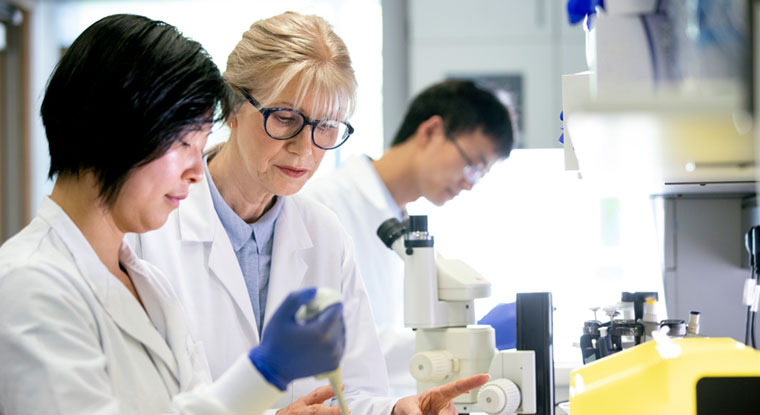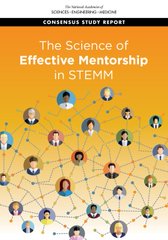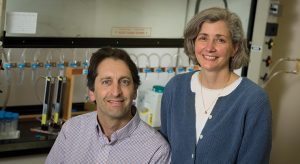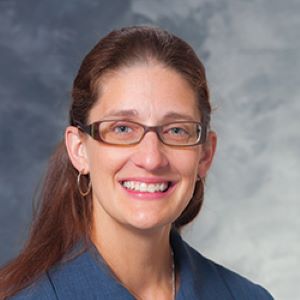UW−Madison Mentorship Experts Anchor Federal Push to Diversify Biomedical Workforce
WCER investigators Christine Pfund, Angela Byars-Winston receive major grants
October 31, 2019 | By Karen Rivedal, WCER Communications

UW-Madison expertise is key to a new $43 million federal effort to bring more women and minorities into the biomedical sciences.
UW−Madison will continue to play a leading role in the second and final phase of a sweeping federal investment in better research mentoring, with responsibility for two major grants in the $43 million follow-up push to boost diversity of students, staff and faculty researchers in the biomedical sciences.
The five-year program starting this fall as part of the NIH’s Diversity Program Consortium follows a $19 million first phase that sought to increase participation of underrepresented groups in the biomedical workforce through development of a National Research Mentoring Network (NRMN) starting in 2014.
That network, which remains active in Phase 2, works to enhance the training and career development of people from diverse backgrounds in biomedical research — including underrepresented populations such as women and minorities — through an online clearinghouse of evidence-based training programs for mentors and mentees, webinars and networking opportunities, including a guided mentoring tool.
UW−Madison was central to Phase 1, serving as a national hub for mentorship training through a $3 million grant awarded to Christine Pfund. Pfund directed the NRMN’s Mentor Training Core as one of five principal NRMN investigators in Phase 1, and also worked as a researcher in the School of Education’s Wisconsin Center for Education Research (WCER) and at the UW Institute for Clinical and Translational Research.
But while the Mentor Training Core gathered a comprehensive suite of programs in culturally responsive mentoring, Phase 2 goes a step further. While continuing to develop mentoring opportunities for biomedical researchers, from undergraduates through early career faculty, Phase 2 focuses on the rigorous testing of selected interventions to determine what approaches work best for whom and in what context.
National profile of mentoring rises with NAS report
The importance of better mentoring has been increasingly recognized across government and academia over the past decade as a driver for improved career satisfaction, progression and productivity in many fields of work and academic pursuits, but especially as a tool to broaden participation in the disciplines of science, technology, engineering, math and medicine (STEMM).

Report cover
This week, mentoring’s ascending role was recognized with the release of a comprehensive consensus study on the science of effective mentorship in STEMM by the National Academy of Sciences.
The 287-page report, plus an online guide to recommended tools and resources, was produced by a national ad hoc committee led by Angela Byars-Winston, a UW−Madison Department of Medicine professor and investigator with WCER’s Center for the Improvement of Mentored Experiences in Research. Pfund, who directs CIMER, also is among the committee’s 12 members, in a dual nod to UW−Madison’s 15-year record of working to improve research-based mentorship.
A consensus report matters in part because it acts to collate and critically review all the evidence-based findings on a given science or topic, plus identify gaps in knowledge and directions for future research.
“There’s so much we still don’t know,” Byars-Winston says. “The traditional dyad of mentoring (one faculty member/one student) is just one model. We also know that peer mentorship and having multiple faculty mentors can be effective. What has the best impact, and for who? Does it matter if we have the same race and gender? We also have a lot of wonderful studies that exist, but replication is everything.”
UW−Madison unique in Phase 2 representation
In Phase 2, the five cores* that made up NRMN’s first phase, including Pfund’s Mentor Training Core, cease to exist. In their place is a resource center, coordination center and a third arm made up of 11 research projects using experimental designs to expand the scientific scope of the NRMN initiative.
The 11 independent research projects are based at institutions across the country and must be focused around one of three primary areas of intervention determined to enhance mentoring and networking: the science of mentoring, professional networks and the navigation of critical career-transition points.
Pfund received a $5.4 million grant to lead the coordination center in Phase 2 of the NRMN initiative. In addition, Byars-Winston was awarded a $3 million grant as director of one of the 11 research projects: a nationwide intervention to train 600 faculty mentors of doctoral students in 32 biomedical programs, including one in-person training session for each participant.
That representation puts UW−Madison in rare air, as the only institution in the country to boast PIs in two of the three branches that make up Phase 2 of the NRMN initiative.
“No one else in the initiative has two,” Pfund says. “It’s an exciting time.”
Pfund leads coordination center in Phase 2
During Phase 2, the resource center, to be run by the University of North Texas’ Health Science Center with a $4.6 million grant, is tasked with managing and continuing to refine the guided mentoring tool and the NRMN website, including regular posting of public reports on the 11 research projects’ progress.
The coordination center, meanwhile, will coordinate the early stages of data collection from the research projects and provide feedback to “promote synergies” between the resource center and the 11 projects to catalyze and maximize research benefits, according to the National Institutes of Health (NIH)
Christine Pfund
“Specifically, the NRMN Coordination Center will create the infrastructure to support substantial coordination, collection, storage, tracking, and reporting of all NRMN data, as well as implement responsive communication strategies that will effectively and efficiently build communities of inclusive practice, foster research innovations, and disseminate key findings,” the NIH says.
Pfund says her team is “thrilled” to lead the coordination center in NRMN’s second phase.
“Our goal is to support NRMN research projects through collaboration to seize long-term potential across the collective,” she says. “Continuing the important work started in Phase I, we will provide the infrastructure needed to help the resource center and the 11 research project investigators maximize their knowledge about which interventions work, for what populations, and under what conditions. We will strive to create synergy across diverse projects and ideas to achieve a holistic perspective, thus contributing to NIH’s ability to shift the paradigm in biomedical research workforce development.”
Pfund says she plans that the coordination center also will:
- bring together investigators’ “diverse cultural experiences, perspectives, expertise, disciplines, and theoretical frameworks as they work to increase diversity in the biomedical workforce.”
- catalyze collaborations to generate new knowledge over the next five years.
- lay the groundwork for the next decade of research in the areas of mentoring, professional development and networking.
600 mentors to be trained with Byars-Winston grant
Byars-Winston says her team has confirmed about half of the 600 faculty mentors who will participate in her research project – titled “Impact of Culturally Aware Mentoring Interventions on Research Mentors and Graduate Training Programs,” – with recruiting underway starting this week for the rest.
Designed to facilitate the academic success of biomedical doctoral students by training their faculty mentors to better reach them through culturally aware mentoring practices, the project will measure both individual outcomes and any organizational changes seen in mentors’ departmental cultures.
Angela Byars-Winston
Department culture matters, Byars-Winston notes, because it often communicates “who belongs in science” through the messages it sends with its policies, practices and training programs.
“It’s about who gets selected to report the research coming out of a project, or who gets nominated for an award or whose work is valued in the newsletter,” she says. “Does the department communicate a climate that says, ‘We believe in every student’s success’? Or is it more about winnowing people out, telling them, ‘Take one look to your left and one to your right, and one of you won’t be here next year’?”
The basics of good mentorship include aligning expectations between mentor and mentee and having clear communications, while a key adjustment for many would-be mentors in biomedical science is just accepting that mentoring is a practice that can be learned – that it’s not just innate or not, and that it’s not the same as being competent in a particular discipline, Byars-Winston says.
“We see that attitude, especially in research mentoring, and we want to shift that,” she says. “It is a learned skill, there are competencies, you can be educated to do it better.”
Everyone wants to ‘feel valued and heard’
When teaching faculty mentors about the culturally aware aspects of research mentoring, Byars-Winston says the key is respecting differences while recognizing aspects of universality.
“We start with understanding that we’re all cultural beings,” she says. “Whether I’m a white male or a Chinese woman or some other gender/ethnicity, I start off with the idea that we all have culture, and the last common denominator is that every individual wants to feel valued and heard.”
The curriculum in her research project is to be provided online and in-person, with one testing variable focused around when the in-person intervention occurs. In Phase 1, the program was offered only in one eight-hour day, so that factor will be changed up and measured, too.
“We don’t know if we’re going to find the same effectiveness as we did before,” Byars-Winston said. “It really is a true experiment with three different formats and doses.”
Measuring two types of outcomes throughout the study’s five-year window also distinguishes it.
“This is pretty powerful stuff for us because we’ll have the first set of data that we know of in research on STEMM environments that will have this longitudinal experimental study at both the individual and institutional levels,” Byars-Winston says.
The other 10 research projects in Phase 2 include studies to:
- build a diverse biomedical workforce through communication across difference.
- identify the influence of psychosocial support on personal gains and objective career outcomes.
- examine inclusive mentor networks, which includes, as one of the four principal investigators from different institutions, Jo Handelsman, a UW-Madison Vilas Research Professor and mentoring pioneer who now directs the university’s Wisconsin Institute for Discovery.
*Phase 1 also had a core for administration through Boston College; for research resources and outreach at the Morehouse School of Medicine in Atlanta; for professional development offering relevant training other than mentoring, such as grant-writing, run by the University of Utah, School of Medicine; and for mentorship and networking, at the University of North Texas Health Science Center, which handled the initial development and maintenance of the NRMN website, as well as development of the guided, virtual mentorship tool known as MyNRMN. The mentorship programs formerly gathered under the Mentor Training Core and the MyNRMN tool continue to live on the NRMN website.






 Pfund says people need to reflect on their motivations to mentor.
Pfund says people need to reflect on their motivations to mentor.